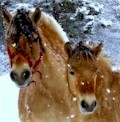Discoveries of man and horse drawings date back to 30,000 B.C. In 638 B.C., the first Olympic games with chariot races like modern day harness racing took place and later became popularized as the "The Sport of Kings." The oldest known breeds are the Arabian and Spanish horses, which later contributed to American breeds. New breeds are continuously being created, as breeders initiate breeding programs specifically designed to select horses to meet special needs.
The horse (Equus caballus) is a large odd-toed ungulate mammal, one of ten modern species of the family Equidae.
Horses have long been among the most economically important domesticated animals; however their importance has declined with the introduction of mechanization. The horse is a prominent figure in the ideals of religion, mythology, and art, as well as playing an important role in transportation, agriculture, and warfare.
Most horses perform work such as carrying humans on their backs or are harnessed to pull objects such as carts or plows. However, hundreds of distinct horse breeds were developed, allowing horses to be specialized for certain tasks; lighter horses for racing or riding, heavier horses for farming and other tasks requiring pulling power. Some horses, such as the miniature horse, can be kept as pets. In industrialized countries, horses are predominantly kept for leisure and sporting pursuits, while in other parts of the world they are used as working animals.
Because horses and humans have lived and worked together for thousands of years, an extensive specialized vocabulary has arisen to describe virtually every horse behavioral and anatomical characteristic with a high degree of precision.
BiologyDepending on breed, management and environment, the domestic horse today has a life expectancy of 25 to 30 years. It is uncommon, but a few horses live into their 40s, and, occasionally, beyond. The oldest verifiable record was "Old Billy," a horse that lived in the 19th century to the age of 62. Regardless of a horse's actual birth date, for most competition purposes, horses are considered a year older on January 1 of each year in the northern hemisphere and August 1 in the southern hemisphere. The exception is endurance riding, where the minimum age to compete is based on the horse's actual calendar age.
The following terminology is used to describe horses of various ages:
![]() Foal: a horse of either sex less than one year old. A nursing foal is sometimes called a suckling and a foal that has been weaned is called a weanling. Most domesticated foals are weaned at 4-6 months of age.
Foal: a horse of either sex less than one year old. A nursing foal is sometimes called a suckling and a foal that has been weaned is called a weanling. Most domesticated foals are weaned at 4-6 months of age.
![]() Yearling: a horse of either sex that is between one and two years old.
Yearling: a horse of either sex that is between one and two years old.
![]() Colt: a male horse under the age of four.
Colt: a male horse under the age of four.
![]() Filly: a female horse under the age of four.
Filly: a female horse under the age of four.
![]() Mare: a female horse four years old and older.
Mare: a female horse four years old and older.
![]() Stallion: a non-castrated male horse four years old and older. Some people, particularly in the UK, refer to a stallion as a "horse." A Ridgling or "Rig" is a stallion which has an undescended testicle. If both testicles are not descended, the horse may appear to be a gelding, but will still behave like a stallion.
Stallion: a non-castrated male horse four years old and older. Some people, particularly in the UK, refer to a stallion as a "horse." A Ridgling or "Rig" is a stallion which has an undescended testicle. If both testicles are not descended, the horse may appear to be a gelding, but will still behave like a stallion.
![]() Gelding: A castrated male horse of any age, though for convenience sake, many people also refer to a young gelding under the age of four as a "colt."
Gelding: A castrated male horse of any age, though for convenience sake, many people also refer to a young gelding under the age of four as a "colt."
